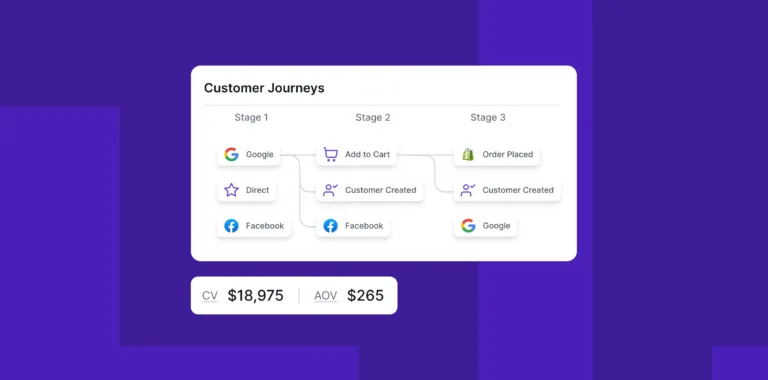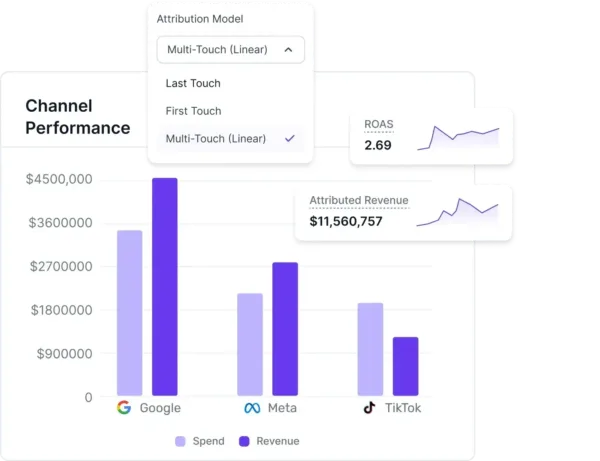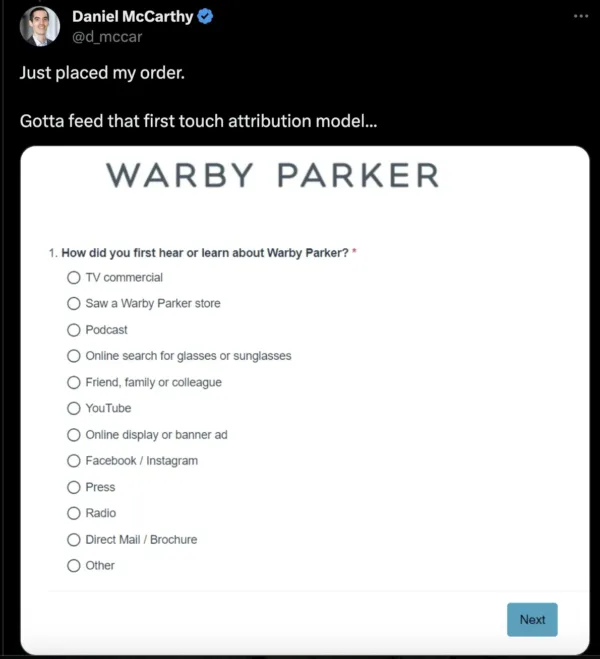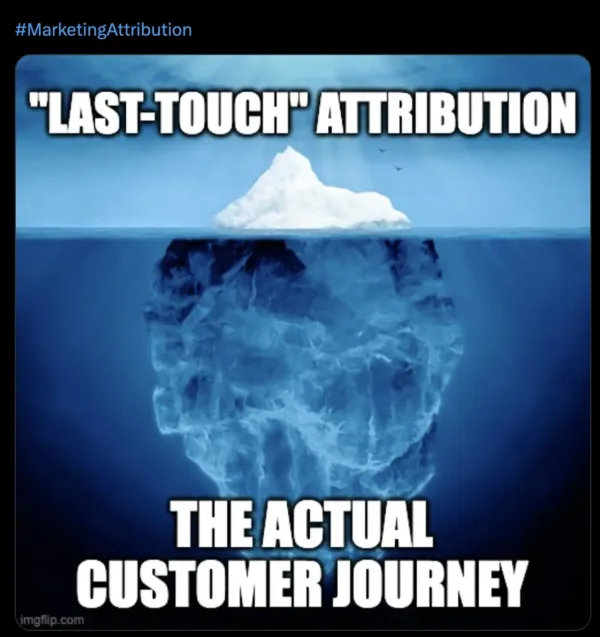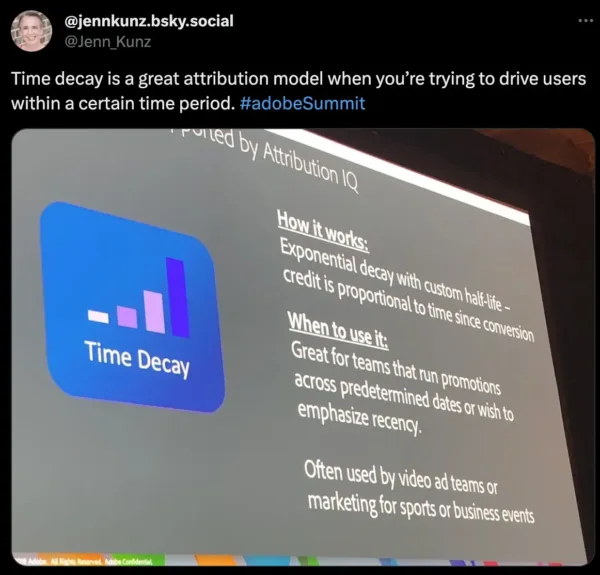A buyer’s journey from discovery to conversion is not linear. Multiple stages, devices, and touchpoints build their interest and persuade them to purchase.
With multiple touchpoints and scattered data all over the internet, a critical question to answer is: how do you craft a unique experience for existing and potential customers?
Here, Multi-Touch Attribution (MTA) comes to the rescue. These models and tools assist brands in measuring the effectiveness of all active touchpoints in a customer’s journey, assigning a proportionate amount of credit to each.
While it’s important to acknowledge that MTA is not as accurate as it once was, due to challenges such as data privacy regulations and cookie restrictions, it still provides useful blended metrics and a deduplicated view of performance. The outcome is a comprehensive understanding of each touchpoint’s role in enhancing conversions, aiding in more informed budget allocation decisions.
Here we discuss what MTA is, the different multi-touch attribution models, its best practices and challenges, and how to measure the impact of MTA.
Understanding Multi-Touch Attribution
What is MTA (Multi-Touch Attribution)?
MTA is the process of determining the impact of each marketing touchpoint in overall conversion. After identifying the best-performing touchpoints, allocate future marketing and ad spending to those specific touchpoints accordingly for higher customer acquisition.
Suppose you define conversion as – the number of visitors booking a demo call. Your current active marketing touchpoints are:
- Facebook ads
- Instagram ads
- Google ads
After a month of running a campaign across all these touchpoints, you notice higher conversions from Facebook ads.
You could allocate more budget to Facebook ads by cutting down a certain percentage from Google ads and Instagram ads (depending on the effectiveness of the other two touchpoints).
Multi-touch attribution solutions take multiple factors into account, such as:
- the cost of each channel,
- current spending in each channel, and
- the impact of these channels on your customer journey.
Attribution models focus on the conversion’s role in the company’s overall revenue (in this case, how many booked demo calls contribute to the company’s ROI).
Now that you know the fundamentals of the multi-touch attribution approach, let’s see how it plays a critical role in marketing campaigns.
Key benefits of using MTA in marketing campaigns
Multi-touch attribution models provide a granular overview of digital campaigns. Some of the benefits of MTA include:
- With customers ignoring generic messages, marketers are leaning toward data-driven marketing to personalize their campaign messaging across different channels. MTA helps them understand which channel to leverage at what point to drive maximum conversion. Marketing attribution builds the base of data-driven marketing infrastructure in your organization.
- Data-driven multi-touch attribution models add more clarity to your spending pattern. Rather than spending blindly on all “popular” marketing channels, this approach identifies the channels and touchpoints that work for your brand. For B2B brands, this would result in shorter sales cycles and higher ROI.
- Unlike single-touch attribution tools that capture the impact of a single marketing channel, multi-touch attribution tools share more context on the effectiveness of more than one (read: multiple) touchpoint on the overall ROI of a business.
How Does Multi-Touch Attribution Work?
In marketing, the moment matters. By “moment,” we mean when a person purchases from your brand. With multi-touch attribution software, you get more context into a user’s journey, what devices they use, and when. With these powerful insights, a brand provides its customers with relevant information they will value at that very moment.
Here are the steps that a multi-touch attribution vendor follows:
Step 1: Data collection
The first step of an attribution algorithm is collecting data related to website visitors, the sources they came from (ads, social media, referrals, and more), and the actions they performed. Brands mostly follow three ways to collect data:
- Use integrations with your CRM, social media, and ad tools among others
- Use Urchin Tracking Modules (UTMs) that share insights related to the source from where a visitor landed on your website by populating the end of your URL
- By plugging JavaScript codes into your website
Step 2: Combining the collected data
With the above sources, you will have a large volume of data. The next hurdle is to combine all these datasets and convert them into data warehouses to store them securely. In B2B businesses, multiple stakeholders are involved in the decision-making process, increasing the length of the sales cycle. That’s partly why attribution tools should opt for account-based modeling for greater clarity on which accounts play key roles in decision-making.
Step 3: Data visualization
In this stage, MTA software visualizes all the combined datasets to convert them into bar charts, pie charts, or graphs. The collected data will look like this:
You’ll have a clear breakdown of the channels, their relevant attribution revenue, and ROAS. Marketers use these insights to develop or pivot their advertising strategies. While creating a similar visualization independently is possible, we don’t recommend it as it requires deep SQL knowledge and the process is long.
Let’s look at the multi-touch attribution models widely used by modern marketers.
Common Models of Multi-Touch Attribution
There are six different types of MTA models. While all these models focus on various marketing touchpoints to identify their conversion potential, the difference lies in the extent to which they measure a channel’s impact on a company’s overall ROI.
Marketers either use these models or create personalized attribution models by making these models as the foundation.
First-touch attribution model
This attribution model credits the first touchpoint directing a customer or prospect to your website. For instance, if a prospect clicks on your LinkedIn ad, visits your product page, reads your blogs, and finally opts for a free trial, the first-touch attribution model will credit the LinkedIn ad as the key touchpoint responsible for this conversion.
Daniel McCarthy, a marketing professor at Emory University, shows an example of a real-life first-touch attribution model in his Twitter post. If you are exploring B2B relationships and lead generation, you might also be wondering, ‘Is Sales Navigator worth it?’ It could be a valuable tool in enhancing your outreach and connection strategies on LinkedIn. Additionally, automation tools like Linked Helper can support these strategies by efficiently managing personalized connection requests, helping you engage with potential leads right from the first touchpoint.
When to use this model?
- Small businesses with limited marketing initiatives and touchpoints opt for this attribution model.
- For medium to large businesses, first-touch attribution is adequate when you want to identify the very first touchpoint that drives a significant part of your conversion.
Limitations
The first-touch attribution model doesn’t emphasize the complexity of modern customer journeys and the impact of multiple touchpoints that influence a customer to purchase.
Last-touch attribution model
A last-touch attribution model is where the last touchpoint a customer or prospect interacts with before visiting your website is given the most credit. For the same use case mentioned above, this model would credit your website blogs as the biggest driving factor behind the conversion.
When to use this model?
If you want to know what prompted buyers to make the purchase decision at the final stage of their customer journey, this attribution model is a perfect fit. It is ideal for small businesses as it doesn’t require much sophistication and is easier to track.
Limitations
This MTA model ignores all the touchpoints that nurtured buyers and persuaded them throughout the customer journey before conversion.
Here is an example of a Twitter meme that truly represents how last-touch attribution models ignore the entire customer journey and prioritize only the last marketing touchpoint.
Linear attribution model
A linear attribution model considers all marketing touchpoints that a potential buyer interacts with before taking an action. However, this model credits each touchpoint uniformly and assumes that all touchpoints are equally responsible for making a conversion.
For example, a user gets an email from an e-commerce store, goes to the website, leaves the store, clicks on an Instagram ad for the same store, and finally makes the purchase. If there are three touchpoints, the linear attribution model will give 33% credit to each touchpoint.
When to use this model?
If you are conducting micro-level market research and want to understand the contributions of each touchpoint in your overall marketing strategy, the linear attribution model is suitable.
Limitations
In reality, each marketing channel doesn’t play the same role in a customer’s journey. Customers might receive tons of emails and coupons from e-commerce stores and still not purchase from them until they see their favorite influencer promoting the product on Instagram.
In that case, Instagram has the biggest impact on the customer, and the linear attribution model fails to capture that.
Time decay attribution model
The time decay attribution model gives more credit to the funnel marketing touchpoints that customers interact with as they are closer to the conversion. But note that this model also focuses on top and bottom-of-the-funnel touchpoints.
In the same example of the ecommerce store, the time decay attribution model will credit the highest attribution to the website and Instagram ad and the least credit to emails.
When to use this model?
- The time decay attribution model is a good starting point for marketers trying to understand the full conversion cycle, with a greater focus on the stages that lead the conversion at the final stages.
- This model is also effective for teams trying to drive conversions within a limited timeframe, like Black Friday and Cyber Monday campaigns.
Jenn Kunz presents a slide from the Adobe Summit that simply explains time decay attribution.
Limitations
This model sometimes over-emphasizes the latest touchpoints before conversion, even though the first few touchpoints may be the actual conversion driving factors.
Position-based attribution model (U-shaped)
The position-based attribution model provides 40% credit each to the first and last touchpoints and 20% to the touchpoints in between. In the same example, the U-shaped model will give the highest credit to emails and Instagram ads and medium credit to the website.
When to use this model?
This attribution model is perfect for situations when marketers already have a good understanding of the entire customer journey but are trying to optimize their messaging for the first and last touchpoints.
Limitations
This model ignores the contributions of the middle touchpoints even though they play a significant role in leading a conversion.
Algorithmic/probabilistic attribution model
The algorithmic attribution model is an advanced marketing attribution model that doesn’t assign pre-decided credits to the marketing touchpoints. It analyzes large volumes of data from multiple sources to determine which channel deserves the highest credit in your customer journey.
When to use this model?
This model is by far the most unbiased multi-touch attribution model. Brands with access to reliable data sources use it to receive authentic insights on their advertising campaigns.
Limitations
As the model heavily relies on data, if the data quality is poor, the outcomes are unreliable.
Multi-Touch Attribution in Action – Case Study of an Online Plant Retailer
The challenges
- Overlapping advertising campaigns resulting in difficulty in identifying the key touchpoints driving the highest conversion
- Complicated customer journey with scattered data over multiple touchpoints like influencer reviews, Google ads, emails
- Previously relied on a misguiding attribution model that affected their budget allocation decisions
The solutions
The plant retailer opted for a data-driven MTA approach by connecting all their data sources with a single MTA platform. This integration allowed them to develop a holistic overview of all marketing touchpoints and their effectiveness in real-time.
The results
40% quarterly sales growth.
Best Practices for Implementing MTA
66% of customers expect brands to tailor messaging to their needs. Marketers require access to data-driven insights to make this happen. Here are the best practices to implement MTA more confidently in your organization.
1) Collect both advertisement and conversion data across channels
B2B marketing involves a lot of fragmented data across multiple channels, often resulting in data overload. B2B marketers miss out on critical data points and the results derived from attribution tools are not authentic.
To avoid this challenge, businesses must integrate their attribution tool with advertisement and conversion touchpoints. This will help you understand the marketing costs and relevant revenue from each touchpoint.
The integration of the attribution tool with advertisement and conversion touchpoints has two-fold advantages:
- Auto-capturing all relevant data from internal and external sources without spending a hefty amount
- Collecting buyer interactions instantly using UTM parameters and click redirects
2) Start with a single channel at the beginning
B2B brands either don’t use attribution models or integrate all their marketing channels with the attribution tool at the beginning of their journey. When this happens, they either don’t have any insights about customers’ journeys or too much data overload leaves them overwhelmed.
The best way to approach this is by starting with a single channel or only one campaign at a time. This will allow you to get a better hold of the attribution tool and gain a good understanding of the customer journey for that channel and what works and what doesn’t work for customers active on that channel.
This way, you will understand one channel completely, build momentum and then move to the next. While this might sound time-consuming, it proves effective for new users.
3) Add enriched signals to your marketing channels
By integrating with a multi-touch attribution tool, marketers track anonymous visits to the website and map their patterns with existing customer databases to create new customer profiles in real time. These insights help you learn more about customers, understand their preferences, and empower your ad channels based on personalized messaging.
Most MTA tools offer CAPI integrations with Facebook, Google Ads, TikTok, and similar platforms to provide marketers with detailed insights without any development effort.
Challenges of Implementing MTA
Despite having all the tools at your disposal, implementing multi-touch attribution models successfully might still have some challenges. These include:
- Inability to get hold of offline data like billboard ads, television ads, and radio ads. Integrating these data points with your attribution tool is challenging. However, these platforms play a significant role in influencing a customer’s decision-making process.
- Except for the probabilistic model, none of the other attribution models produce a holistic view of the customer journey. Therefore, brands must create customized models from scratch to meet their attribution needs.
- MTA is only focused on customer data. Unlike marketing mix modeling, this tool doesn’t consider social, natural, and geo-political factors. Nevertheless, these factors deeply affect buyers’ buying patterns.
Measuring the Impact of MTA
You must know the associated KPIs to leverage MTA in the best possible way. By measuring these KPIs, you will understand whether a marketing attribution tool is making an impact on your business:
- Return on Ad Spend (ROAS) – This metric measures the revenue associated with each $1 you spend on ads.
- Cost per Click (CPC) – Each time someone clicks on your ad, your brand must pay for the click from the overall ad budget, which is called CPC.
- Ad spend – Ad spend is referred to as the total amount you are spending across all advertisement campaigns, including online and offline channels.
- Cost per View (CPV) – This metric applies to video ads. Whenever someone watches your video ad for a specific duration, you need to pay an amount, and it is called CPV. YouTube ads are a good example.
- Link clicks – The overall number of clicks you receive on your links and CTAs is called link clicks.
Conclusion
Marketing is a continuous process. Marketers need to evolve with changing customer buying patterns and trends. Different customers have different needs, and it is impossible to define their journeys with a one-size-fits-all framework.
Multi-touch attribution tools monitor customers’ interactions across various touchpoints, identify the channels they are most active in, and accordingly help marketers personalize their campaigns.
By using attribution tools like Lifesight, businesses will witness:
- Greater clarity over ROAS from different marketing channels
- Defining winning customer journeys
- Integrating all ad channels at one go for a unified overview
Explore Lifesight’s MTA software for enhanced marketing insights.
You may also like
Essential resources for your success
